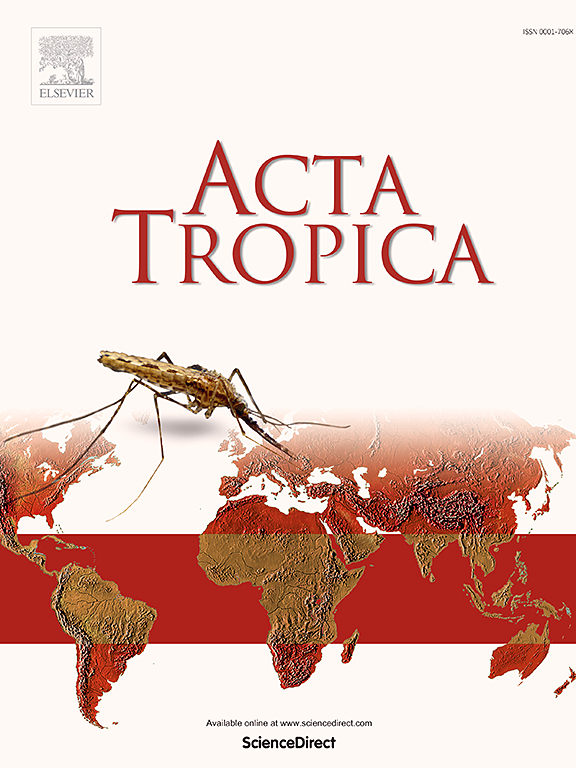First report of Trypanosoma evansi A-type from the Ecuadorian Amazon: Phylogenetic and structural analyses of the VSG RoTat1.2 fragment
IF 2.1
3区 医学
Q2 PARASITOLOGY
引用次数: 0
Abstract
Trypanosoma evansi, a protozoan parasite of the Trypanozoon subgenus, infects domestic and wild animals, and occasionally humans, worldwide. Despite its significant impact on livestock production, epidemiological studies and molecular analyses of T. evansi based on variant surface glycoproteins (VSG) remain limited in South America. We report the first molecular identification of T. evansi in two localities in the Ecuadorian Amazon and provide phylogenetic and structural analyses of the VSG RoTat 1.2 fragment. Using a retrospective biobank approach, we analyzed DNA from blood samples of dogs and horses from small farms in the Orellana and Sucumbíos provinces of the country. Three primer sets targeted the internal transcribed spacer 1 (ITS1), expression site-associated genes 6 and 7 (ESAG6/7), and VSG RoTat 1.2. Sequences were evaluated at both the nucleotide and predicted protein levels. The molecular prevalence was 19 % (5/26), including one dog from Sucumbíos and one dog plus three horses from Orellana. Although ITS and ESAG phylogenies were inconclusive, VSG analysis grouped the Ecuadorian genotypes within a distinct T. evansi clade, separate from Trypanosoma equiperdum and Trypanosoma brucei. The amino acid residues of the VSGs are similar between T. evansi isolates and different from those of the other two species. However, the overall structural conservation of the VSGs analyzed portions of the Trypanozoon species suggests a preserved membrane protein functionality. These findings reveal the silent presence of T. evansi in rural Ecuador, posing risks to animals and highlighting the need for further research on native isolates.

厄瓜多尔亚马逊河流域埃瓦西锥虫a型的首次报道:VSG RoTat1.2片段的系统发育和结构分析
伊文氏锥虫是锥虫亚属的一种原生动物寄生虫,在世界范围内感染家畜和野生动物,偶尔也感染人类。尽管其对畜牧生产产生重大影响,但基于变异表面糖蛋白(VSG)的伊瓦西绦虫流行病学研究和分子分析在南美洲仍然有限。我们报道了厄瓜多尔亚马逊河流域两个地区首次发现的伊瓦西绦虫分子,并对VSG RoTat 1.2片段进行了系统发育和结构分析。使用回顾性生物库方法,我们分析了来自该国Orellana省和Sucumbíos省小型农场的狗和马的血液样本的DNA。3组引物分别靶向内部转录间隔段1 (ITS1)、表达位点相关基因6和7 (ESAG6/7)以及VSG RoTat 1.2。在核苷酸和预测蛋白水平上对序列进行评估。分子患病率为19%(5/26),其中1只狗来自Sucumbíos, 1只狗加3匹马来自Orellana。虽然ITS和ESAG系统发育不确定,但VSG分析将厄瓜多尔的基因型归为一个独特的伊瓦西锥虫分支,与装备锥虫和布鲁氏锥虫分开。伊文氏T. evansi分离株VSGs的氨基酸残基相似,而与其他两种不同。然而,所分析的部分锥虫物种的VSGs的整体结构保存表明保留了膜蛋白功能。这些发现揭示了厄瓜多尔农村地区伊瓦西绦虫的无声存在,对动物构成了风险,并强调需要进一步研究本地分离株。
本文章由计算机程序翻译,如有差异,请以英文原文为准。
求助全文
约1分钟内获得全文
求助全文
来源期刊

Acta tropica
医学-寄生虫学
CiteScore
5.40
自引率
11.10%
发文量
383
审稿时长
37 days
期刊介绍:
Acta Tropica, is an international journal on infectious diseases that covers public health sciences and biomedical research with particular emphasis on topics relevant to human and animal health in the tropics and the subtropics.
 求助内容:
求助内容: 应助结果提醒方式:
应助结果提醒方式:


